A Multimodal and Temporal Network-Based Yield Assessment Method for Different Heat-Tolerant Genotypes of Wheat
Abstract
:1. Introduction
2. Materials and Methods
2.1. Experimental Materials and Design
2.2. Data Collection
2.2.1. Field Data Collection
2.2.2. UAV Image Acquisition
2.3. Image Preprocessing
2.4. Canopy Information Extraction
2.4.1. Canopy Spectral Information
2.4.2. Canopy Structure Information
2.5. Building the Dataset
2.6. LSTM Network Model
3. Results
3.1. Obtaining Yield Information
3.2. Canopy Information Acquisition
3.2.1. Spectral Index
3.2.2. Canopy Height Observation
3.3. Multi-Species Yield Estimates
3.4. Species Classification Validation
3.5. Multi-Genotype-Based Yield Estimation
3.5.1. Spectral-Index-Based Yield Regression
3.5.2. Yield Regression Based on Spectral Index Combined with Canopy
3.6. Comparison and Application of Yield Forecasting
4. Discussion
5. Conclusions
Author Contributions
Funding
Data Availability Statement
Conflicts of Interest
References
- Zhu, Y.H.; Wei, C.C.; Chi, Y.B.; Yang, P.L. The Influencing Mechanisms of Reclaimed Water on N2O Production in a Multiyear Maize-Wheat Rotation. Agronomy 2023, 13, 2393. [Google Scholar] [CrossRef]
- Hickey, L.T.; Hafeez, A.N.; Robinson, H.; Jackson, S.A.; Leal-Bertioli, S.C.M.; Tester, M.; Gao, C.; Godwin, I.D.; Hayes, B.J.; Wulff, B.B.H. Breeding crops to feed 10 billion. Nat. Biotechnol. 2019, 37, 744–754. [Google Scholar] [CrossRef]
- Bergkamp, B.; Somayanda, I.; Asebedo, A.R.; Fritz, A.K.; Jagadish, K. Prominent winter wheat varieties response to post-flowering heat stress under controlled chambers and field based heat tents. Field Crops Res. 2018, 222, 143–152. [Google Scholar] [CrossRef]
- Prasad, P.V.V.; Maduraimuthu, D. Response of floret fertility and individual grain weight of wheat to high temperature stress: Sensitive stages and thresholds for temperature and duration. Funct. Plant Biol. 2014, 41, 1261. [Google Scholar] [CrossRef]
- Darguza, M.; Gaile, Z. The Productivity of Crop Rotation Depending on the Included Plants and Soil Tillage. Agriculture 2023, 13, 1751. [Google Scholar] [CrossRef]
- Xu, X.X.; Liu, S.; Meng, F.A.; Zhang, X.; Zhao, J.K.; Qu, W.K.; Shi, Y.; Zhao, C.X. Grain Yield Formation and Nitrogen Utilization Efficiency of Different Winter Wheat Varieties under Rainfed Conditions in the Huang-Huai-Hai Plain. Agronomy 2023, 13, 915. [Google Scholar] [CrossRef]
- Yang, F.Q.; Liu, Y.; Yan, J.Y.; Guo, L.X.; Tan, J.X.; Meng, X.F.; Xiao, Y.B.; Feng, H.K. Winter Wheat Yield Estimation with Color Index Fusion Texture Feature. Agriculture 2024, 14, 581. [Google Scholar] [CrossRef]
- Zhu, J.K.; Li, Y.M.; Wang, C.Y.; Liu, P.; Lan, Y.B. Method for Monitoring Wheat Growth Status and Estimating Yield Based on UAV Multispectral Remote Sensing. Agronomy 2024, 14, 991. [Google Scholar] [CrossRef]
- Liu, T.; Wu, F.; Mou, N.N.; Zhu, S.L.; Yang, T.L.; Zhang, W.J.; Wang, H.; Wu, W.; Zhao, Y.Y.; Sun, C.M.; et al. The estimation of wheat yield combined with UAV canopy spectral and volumetric data. Food Energy Secur. 2024, 13, e527. [Google Scholar] [CrossRef]
- Maimaitijiang, M.; Ghulam, A.; Sidike, P.; Hartling, S.; Maimaitiyiming, M.; Peterson, K.; Shavers, E.; Fishman, J.; Peterson, J.; Kadam, S. Unmanned Aerial System (UAS)-based phenotyping of soybean using multi-sensor data fusion and extreme learning machine. ISPRS J. Photogramm. Remote Sens. 2017, 134, 43–58. [Google Scholar] [CrossRef]
- Sagan, V.; Maimaitijiang, M.; Sidike, P.; Maimaitiyiming, M.; Fritschi, F.B. UAV/Satellite Multiscale Data Fusion for Crop Monitoring and Early Stress Detection. In Proceedings of the 4th ISPRS Geospatial Week 2019, Enschede, The Netherlands, 10–14 June 2019. [Google Scholar]
- Liu, S.C.; Huang, Z.; Xu, Z.H.; Zhao, F.J.; Xiong, D.L.; Peng, S.B.; Huang, J.L. High-throughput measurement method for rice seedling based on improved UNet model. Comput. Electron. Agric. 2024, 219, 108770. [Google Scholar] [CrossRef]
- Ma, F.M.; Wang, M.Y.; Yan, N.; Adnan, M.; Jiang, F.H.; Hu, Q.; He, G.Y.; Shen, Y.J.; Wan, Y.; Yang, Y.X.; et al. A fast and efficient phenotyping method to estimate sugarcane stalk bending properties using near-infrared spectroscopy. Eur. J. Agron. 2024, 154, 127107. [Google Scholar] [CrossRef]
- Zhu, H.L.; Huang, Y.W.; An, Z.K.; Zhang, H.; Han, Y.Y.; Zhao, Z.H.; Li, F.F.; Zhang, C.; Hou, C.C. Assessing radiometric calibration methods for multispectral UAV imagery and the influence of illumination, flight altitude and flight time on reflectance, vegetation index and inversion of winter wheat AGB and LAI. Comput. Electron. Agric. 2024, 219, 108821. [Google Scholar] [CrossRef]
- Meiyan, S.; Mengyuan, S.; Qizhou, D.; Xiaohong, Y.; Baoguo, L.; Yuntao, M. Estimating the maize above-ground biomass by constructing the tridimensional concept model based on UAV-based digital and multi-spectral images. Field Crops Res. 2022, 282, 108491. [Google Scholar] [CrossRef]
- Fei, S.; Hassan, M.A.; He, Z.; Chen, Z.; Shu, M.; Wang, J.; Li, C.; Xiao, Y. Assessment of Ensemble Learning to Predict Wheat Grain Yield Based on UAV-Multispectral Reflectance. Remote Sens. 2021, 13, 2338. [Google Scholar] [CrossRef]
- Hassan, M.A.; Yang, M.; Rasheed, A.; Yang, G.; Reynolds, M.; Xia, X.; Xiao, Y.; He, Z. A rapid monitoring of NDVI across the wheat growth cycle for grain yield prediction using a multi-spectral UAV platform. Plant Sci. 2019, 282, 95–103. [Google Scholar] [CrossRef]
- Yang, B.; Zhu, Y.; Wang, M.; Ning, J. A Model for Yellow Tea Polyphenols Content Estimation Based on Multi-Feature Fusion. IEEE Access 2019, 7, 180054–180063. [Google Scholar] [CrossRef]
- Xia, L.; Zhang, R.; Chen, L.; Li, L.; Yi, T.; Wen, Y.; Ding, C.; Xie, C. Evaluation of Deep Learning Segmentation Models for Detection of Pine Wilt Disease in Unmanned Aerial Vehicle Images. Remote Sens. 2021, 13, 3594. [Google Scholar] [CrossRef]
- Elsayed, S.; Elhoweity, M.; Ibrahim, H.H.; Dewir, Y.H.; Migdadi, H.M.; Schmidhalter, U. Thermal imaging and passive reflectance sensing to estimate the water status and grain yield of wheat under different irrigation regimes. Agric. Water Manag. 2017, 189, 98–110. [Google Scholar] [CrossRef]
- Yu, N.; Li, L.; Schmitz, N.; Tian, L.F.; Greenberg, J.A.; Diers, B.W. Development of methods to improve soybean yield estimation and predict plant maturity with an unmanned aerial vehicle based platform. Remote Sens. Environ. 2016, 187, 91–101. [Google Scholar] [CrossRef]
- Zhang, W.L.; Niu, S.D.; Yao, J.X.; Zhang, Y.P.; Li, X.; Dong, H.X.; Si, S.; Li, H.; Li, X.L.; Ren, J.H.; et al. Responses of Physiological Traits and Grain Yield to Short Heat Stress during Different Grain-Filling Stages in Summer Maize. Agronomy 2023, 13, 2126. [Google Scholar] [CrossRef]
- Liu, Q.X.; Wang, J.S.; Wu, A.L.; Sun, A.Q.; Dong, E.R.; Wang, Y.; Huang, X.L.; Hu, H.W.; Jiao, X.Y. Plant-associated microorganisms during the reproductive period best predict sorghum yield and quality. Field Crops Res. 2023, 304, 109167. [Google Scholar] [CrossRef]
- Geipel, J.; Link, J.; Claupein, W. Combined Spectral and Spatial Modeling of Corn Yield Based on Aerial Images and Crop Surface Models Acquired with an Unmanned Aircraft System. Remote Sens. 2014, 6, 10335–10355. [Google Scholar] [CrossRef]
- Bendig, J.; Yu, K.; Aasen, H.; Bolten, A.; Bennertz, S.; Broscheit, J.; Gnyp, M.L.; Bareth, G. Combining UAV-based plant height from crop surface models, visible, and near infrared vegetation indices for biomass monitoring in barley. Int. J. Appl. Earth Obs. Geoinf. 2015, 39, 79–87. [Google Scholar] [CrossRef]
- Galvão, L.; Breunig, F.; Santos, J.; Moura, Y. View-illumination effects on hyperspectral vegetation indices in the Amazonian tropical forest. Int. J. Appl. Earth Obs. Geoinf. 2013, 21, 291–300. [Google Scholar] [CrossRef]
- Vollenweider, P.; Günthardt-Goerg, M. Diagnosis of abiotic and biotic stress factors using the visible symptoms in foliage. Environ. Pollut. 2006, 140, 562–571. [Google Scholar] [CrossRef]
- Araus, J.L.; Kefauver, S.C.; Zaman-Allah, M.; Olsen, M.S.; Cairns, J.E. Translating High-Throughput Phenotyping into Genetic Gain. Trends Plant Sci. 2018, 23, 451–466. [Google Scholar] [CrossRef]
- Hernandez, J.; Lobos, G.A.; Matus, I.; Del Pozo, A.; Silva, P.; Galleguillos, M. Using Ridge Regression Models to Estimate Grain Yield from Field Spectral Data in Bread Wheat (Triticum aestivum L.) Grown under Three Water Regimes. Remote Sens. 2015, 7, 2109–2126. [Google Scholar] [CrossRef]
- Furbank, R.; Tester, M. Phenomics—Technologies to relieve the phenotyping bottleneck. Trends Plant Sci. 2011, 16, 635–644. [Google Scholar] [CrossRef]
- Großkinsky, D.; Svensgaard, J.; Christensen, S.; Roitsch, T. Plant phenomics and the need for physiological phenotyping across scales to narrow the genotype-to-phenotype knowledge gap. J. Exp. Bot. 2015, 66, 5429–5440. [Google Scholar] [CrossRef]
- He, S.Y.; Li, X.N.; Chen, M.G.; Xu, X.Y.; Tang, F.D.; Gong, T.; Xu, M.; Yang, W.Y.; Liu, W.G. Crop HTP Technologies: Applications and Prospects. Agriculture 2024, 14, 723. [Google Scholar] [CrossRef]
- Akhtar, M.S.; Zafar, Z.; Nawaz, R.; Fraz, M.M. Unlocking plant secrets: A systematic review of 3D imaging in plant phenotyping techniques. Comput. Electron. Agric. 2024, 222, 109033. [Google Scholar] [CrossRef]
- Fahlgren, N.; Gehan, M.; Baxter, I. Lights, camera, action: High-throughput plant phenotyping is ready for a close-up. Curr. Opin. Plant Biol. 2015, 24, 93–99. [Google Scholar] [CrossRef]
- Bort, J.; Casadesús, J.; Nachit, M.; Araus, J. Factors affecting the grain yield predicting attributes of spectral reflectance indices in durum wheat: Growing conditions, genotype variability and date of measurement. Int. J. Remote Sens. 2005, 26, 2337–2358. [Google Scholar] [CrossRef]
- Bowman, B.C.; Chen, J.; Zhang, J.; Wheeler, J.; Wang, Y.; Zhao, W.; Nayak, S.; Heslot, N.; Bockelman, H.; Bonman, J. Evaluating Grain Yield in Spring Wheat with Canopy Spectral Reflectance. Crop Sci. 2015, 55, 1881–1890. [Google Scholar] [CrossRef]
- Fei, S.; Hassan, M.A.; Xiao, Y.; Rasheed, A.; Xia, X.; Ma, Y.; Fu, L.; Chen, Z.; He, Z. Application of multi-layer neural network and hyperspectral reflectance in genome-wide association study for grain yield in bread wheat. Field Crops Res. 2022, 289, 108730. [Google Scholar] [CrossRef]
- Kong, J.Y.; Luo, Z.H.; Zhang, C.; Tang, M.; Liu, R.; Xie, Z.; Feng, S.Y. Identification of Robust Hybrid Inversion Models on the Crop Fraction of Absorbed Photosynthetically Active Radiation Using PROSAIL Model Simulated and Field Multispectral Data. Agronomy 2023, 13, 2147. [Google Scholar] [CrossRef]
- Kim, N.; Ha, K.-J.; Park, N.-W.; Cho, J.; Hong, S.; Lee, Y. A Comparison Between Major Artificial Intelligence Models for Crop Yield Prediction: Case Study of the Midwestern United States, 2006–2015. ISPRS Int. J. Geo-Inf. 2019, 8, 240. [Google Scholar] [CrossRef]
- Maimaitijiang, M.; Sagan, V.; Sidike, P.; Hartling, S.; Esposito, F.; Fritschi, F.B. Soybean yield prediction from UAV using multimodal data fusion and deep learning. Remote Sens. Environ. 2020, 237, 111599. [Google Scholar] [CrossRef]
- Hu, G.; Yang, Y.; Dong, Y.; Kittler, J.; Hospedales, T. When Face Recognition Meets with Deep Learning: An Evaluation of Convolutional Neural Networks for Face Recognition. In Proceedings of the IEEE international conference on computer vision workshops 2015, Santiago, Chile, 7–13 December 2015. [Google Scholar]
- Fotheringham, A.S.; Crespo, R.; Yao, J. Geographical and Temporal Weighted Regression (GTWR). Geogr. Anal. 2015, 47, 431–452. [Google Scholar] [CrossRef]
- Cao, L.; San, X.; Zhao, Y.; Chen, G. The application of the spatio-temporal data mining algorithm in maize yield prediction. Math. Comput. Model. 2013, 58, 507–513. [Google Scholar] [CrossRef]
- Liu, Y.; Liang, H.; Lv, X.; Liu, D.; Wen, X.; Liao, Y. Effect of polyamines on the grain filling of wheat under drought stress. Plant Physiol. Biochem. 2016, 100, 113–129. [Google Scholar] [CrossRef] [PubMed]
- Han, X.; Thomasson, J.; Bagnall, G.; Pugh, N.; Horne, D.; Rooney, W.; Jung, J.; Chang, A.; Malambo, L.; Popescu, S.; et al. Measurement and Calibration of Plant-Height from Fixed-Wing UAV Images. Sensors 2018, 18, 4092. [Google Scholar] [CrossRef] [PubMed]
- Volpato, L.; Pinto, F.; González-Pérez, L.; Thompson, I.; Borém, A.; Reynolds, M.; Gerard, B.; Molero, G.; Rodrigues, F. High Throughput Field Phenotyping for Plant Height Using UAV-Based RGB Imagery in Wheat Breeding Lines: Feasibility and Validation. Front. Plant Sci. 2021, 12, 591587. [Google Scholar] [CrossRef]
- Guojie, R.; Li, X.; Yuan, F.; Cammarano, D.; Ata-Ul-Karim, S.; Liu, X.-J.; Tian, Y.; Zhu, Y.; Cao, W.; Cao, Q. Improving wheat yield prediction integrating proximal sensing and weather data with machine learning. Comput. Electron. Agric. 2022, 195, 106852. [Google Scholar] [CrossRef]
- Duan, B.; Liu, Y.; Gong, Y.; Peng, Y.; Wu, X.; Zhu, R.; Fang, S. Remote estimation of rice LAI based on Fourier spectrum texture from UAV image. Plant Methods 2019, 15, 124. [Google Scholar] [CrossRef] [PubMed]
- Tucker, C. Red and Photographic Infrared Linear Combinations for Monitoring Vegetation. Remote Sens. Environ. 1979, 8, 127–150. [Google Scholar] [CrossRef]
- Huete, A.; Didan, K.; Miura, T.; Rodriguez, E.; Gao, X.; Ferreira, L.G. Overview of the Radiometric and Biophysical Performance of the MODIS Vegetation Indices. Remote Sens. Environ. 2002, 83, 195–213. [Google Scholar] [CrossRef]
- Jiang, Z.; Huete, A.; Didan, K.; Miura, T. Development of a two-band enhanced vegetation index without a blue band. Remote Sens. Environ. 2008, 112, 3833–3845. [Google Scholar] [CrossRef]
- Rondeaux, G.; Steven, M.; Frederic, B. Optimization of Soil-Adjusted Vegetation Indices. Remote Sens. Environ. 1996, 55, 95–107. [Google Scholar] [CrossRef]
- Roujean, J.-L.; Breon, F.-M. Estimating PAR absorbed by vegetation from bidirectional reflectance measurements. Remote Sens. Environ. 1995, 51, 375–384. [Google Scholar] [CrossRef]
- Sripada, R.; Heiniger, R.; White, J.; Meijer, A. Aerial Color Infrared Photography for Determining Early In-Season Nitrogen Requirements in Corn. Agron. J. 2006, 98, 968–977. [Google Scholar] [CrossRef]
- Daughtry, C.; Walthall, C.; Kim, M.; Colstoun, E.B.; McMurtrey, J.E. Estimating Corn Leaf Chlorophyll Concentration from Leaf and Canopy Reflectance. Remote Sens. Environ. 2000, 74, 229–239. [Google Scholar] [CrossRef]
- Justice, C.; Vermote, E.; Townshend, J.; Defries, R.; Roy, D.; Hall, D.; Salomonson, V.; Privette, J.; Riggs, G.; Strahler, A. The Moderate Resolution Imaging Spectroradiometer (MODIS): Land Remote Sensing for Global Change Research. IEEE Trans. Geosci. Remote Sens. 1998, 36, 1228–1249. [Google Scholar] [CrossRef]
- Rouse, J.; Haas, R.; Schell, J.; Deering, D. Monitoring Vegetation Systems in the Great Plains with ERTS. NASA Spec. Publ. 1974, 351, 309. [Google Scholar]
- Zohaib, K.; Joshua, C.; Jinhai, C.; Vahid-Rahimi, E.; Stephan, H.; Stanley, M. Quantitative Estimation of Wheat Phenotyping Traits Using Ground and Aerial Imagery. Remote Sens. 2018, 10, 950. [Google Scholar]
- Chang, A.; Eo, Y.D.; Kim, S.; Kim, Y.; Kim, Y. Canopy-cover thematic-map generation for Military Map products using remote sensing data in inaccessible areas. Landsc. Ecol. Eng. 2010, 7, 263–274. [Google Scholar] [CrossRef]
- Zarco-Tejada, P.; Díaz Varela, R.; Angileri, V.; Loudjani, P. Tree height quantification using very high resolution imagery acquired from an unmanned aerial vehicle (UAV) and automatic 3D photo-reconstruction methods. Eur. J. Agron. 2014, 55, 89–99. [Google Scholar] [CrossRef]
- Wei, L.G.; Wang, Q.; Niu, K.; Bai, S.H.; Wei, L.; Qiu, C.H.; Han, N.N. Design and Test of Seed-Fertilizer Replenishment Device for Wheat Seeder. Agriculture 2024, 14, 374. [Google Scholar] [CrossRef]
- Su, H.; Tianyi, Z.; Lin, M.; Lu, W.; Yan, X.-H. Predicting subsurface thermohaline structure from remote sensing data based on long short-term memory neural networks. Remote Sens. Environ. 2021, 260, 112465. [Google Scholar] [CrossRef]
- Pullanagari, R.R.; Dehghan-Shoar, M.; Yule, I.J.; Bhatia, N. Field spectroscopy of canopy nitrogen concentration in temperate grasslands using a convolutional neural network. Remote Sens. Environ. Interdiscip. J. 2021, 257, 112353. [Google Scholar] [CrossRef]
- Wang, S.; Guan, K.; Zhang, C.; Lee, D.; Margenot, A.J.; Ge, Y.; Peng, J.; Zhou, W.; Zhou, Q.; Huang, Y. Using soil library hyperspectral reflectance and machine learning to predict soil organic carbon: Assessing potential of airborne and spaceborne optical soil sensing. Remote Sens. Environ. 2022, 271, 112914. [Google Scholar] [CrossRef]
- Wang, L.; Tian, Y.; Yao, X.; Zhu, Y.; Cao, W. Predicting grain yield and protein content in wheat by fusing multi-sensor and multi-temporal remote-sensing images. Field Crops Res. 2014, 164, 178–188. [Google Scholar] [CrossRef]
- Maduraimuthu, D.; Boyle, D.; Welti, R.; Jagadish, K.; Prasad, P.V.V. Decreased photosynthetic rate under high temperature in wheat is due to lipid desaturation, oxidation, acylation, and damage of organelles. BMC Plant Biol. 2018, 18, 55. [Google Scholar] [CrossRef]
- Yu, D.; Zha, Y.; Shi, L.; Jin, X.; Hu, S.; Yang, Q.; Huang, K.; Zeng, W. Improvement of sugarcane yield estimation by assimilating UAV-derived plant height observations. Eur. J. Agron. 2020, 121, 126159. [Google Scholar] [CrossRef]
- Han, S.; Zhang, Y.; Cao, J.; Yun, L.; Li, Y.-S. Prediction of Winter Wheat Yield Based on Multi-Source Data and Machine Learning in China. Remote Sens. 2020, 12, 236. [Google Scholar] [CrossRef]
- Sakamoto, T. Incorporating environmental variables into a MODIS-based crop yield estimation method for United States corn and soybeans through the use of a random forest regression algorithm. ISPRS J. Photogramm. Remote Sens. 2020, 160, 208–228. [Google Scholar] [CrossRef]
- Kamir, E.; Waldner, F.; Hochman, Z. Estimating wheat yields in Australia using climate records, satellite image time series and machine learning methods. ISPRS J. Photogramm. Remote Sens. 2020, 160, 124–135. [Google Scholar] [CrossRef]
- Nevavuori, P.; Narra, N.; Lipping, T. Crop yield prediction with deep convolutional neural networks. Comput. Electron. Agric. 2019, 163, 104859. [Google Scholar] [CrossRef]
- Qiao, M.; He, X.; Cheng, X.; Li, P.; Luo, H.; Zhang, L.; Tian, Z. Crop yield prediction from multi-spectral, multi-temporal remotely sensed imagery using recurrent 3D convolutional neural networks. Int. J. Appl. Earth Obs. Geoinf. 2021, 102, 102436. [Google Scholar] [CrossRef]
- Ahmadi, A.; Baker, D.A. The effect of water stress on the activities of key regulatory enzymes of the sucrose to starch pathway in wheat. Plant Growth Regul. 2001, 35, 81–91. [Google Scholar] [CrossRef]
- Smertenko, A.; Draber, P.; ViklickÝ, V.; Opatrný, Z. Heat stress affects the organisation of microtubules and cell division in Nicotiana tabacum. Plant Cell Environ. 2008, 20, 1534–1542. [Google Scholar] [CrossRef]
- Farooq, M.; Bramley, H.; Palta, J.; Siddique, K. Heat Stress in Wheat during Reproductive and Grain-Filling Phases. Crit. Rev. Plant Sci. 2011, 30, 491–507. [Google Scholar] [CrossRef]
- Zhao, K.; Tao, Y.; Liu, M.; Yang, D.; Zhu, M.; Ding, J.; Zhu, X.; Guo, W.; Zhou, G.; Li, C. Does temporary heat stress or low temperature stress similarly affect yield, starch, and protein of winter wheat grain during grain filling? J. Cereal Sci. 2022, 103, 103408. [Google Scholar] [CrossRef]
- Lesk, C.; Rowhani, P.; Ramankutty, N. Influence of extreme weather disasters on global crop production. Nature 2016, 529, 84–87. [Google Scholar] [CrossRef]
- Natu, P.; Kv, S.; Ghildiyal, M. Heat Shock Protein in Developing Grains in Relation to Thermotolerance for Grain Growth in Wheat. J. Agron. Crop Sci. 2009, 196, 76–80. [Google Scholar] [CrossRef]
- Min, L.; Hui, S.; Yangyang, L.; Jinpeng, L.; Jincai, L.; Yulei, Z.; Youhong, S. Analysis of Heat Tolerance of Wheat with Different Genotypes and Screening of ldentification lndexes in Huang-Huai-Hai Region. Sci. Agric. Sin. 2021, 54, 3381–3393. (In Chinese) [Google Scholar]
- Zhou, R.; Kjaer, K.; Rosenqvist, E.; Yu, X.; Wu, Z.; Ottosen, C.-O. Physiological Response to Heat Stress During Seedling and Anthesis Stage in Tomato Genotypes Differing in Heat Tolerance. J. Agron. Crop Sci. 2016, 203, 68–80. [Google Scholar] [CrossRef]
- Kefauver, S.; Vicente, R.; Vergara Diaz, O.; Fernandez-Gallego, J.; Kerfal, S.; López, A.; Melichar, J.; Serret, M.; Araus, J. Comparative UAV and Field Phenotyping to Assess Yield and Nitrogen Use Efficiency in Hybrid and Conventional Barley. Front. Plant Sci. 2017, 8, 1733. [Google Scholar] [CrossRef] [PubMed]
- Gutierrez, M.; Reynolds, M.; Raun, W.; Stone, M.; Klatt, A. Spectral Water Indices for Assessing Yield in Elite Bread Wheat Genotypes under Well-Irrigated, Water-Stressed, and High-Temperature Conditions. Crop Sci. 2010, 50, 197–214. [Google Scholar] [CrossRef]
- Rajcan, I.; Swanton, C. Understanding maize-weed competition: Resource competition, light quality and the whole plant. Field Crops Res. 2001, 71, 139–150. [Google Scholar] [CrossRef]
- Vergara Diaz, O.; Zaman-Allah, M.; Masuka, B.; Hornero, A.; Zarco-Tejada, P.; Prasanna, B.; Cairns, J.; Araus, J. A Novel Remote Sensing Approach for Prediction of Maize Yield Under Different Conditions of Nitrogen Fertilization. Front. Plant Sci. 2016, 7, 666. [Google Scholar] [CrossRef] [PubMed]
- Rischbeck, P.; Elsayed, S.; Mistele, B.; Barmeier, G.; Heil, K.; Schmidhalter, U. Data fusion of spectral, thermal and canopy height parameters for improved yield prediction of drought stressed spring barley. Eur. J. Agron. 2016, 78, 44–59. [Google Scholar] [CrossRef]
- Michael, S.; Giebel, A.; Gleiniger, F.; Pflanz, M.; Lentschke, J.; Dammer, K.-H. Monitoring Agronomic Parameters of Winter Wheat Crops with Low-Cost UAV Imagery. Remote Sens. 2016, 8, 706. [Google Scholar] [CrossRef]
- Plaut, Z.; Butow, B.J.; Blumenthal, C.; Wrigley, C. Transport of dry matter into developing wheat kernels and its contribution to grain yield under post-anthesis water deficit and elevated temperature. Field Crops Res. 2004, 86, 185–198. [Google Scholar] [CrossRef]
- Maduraimuthu, D.; Narayanan, S.; Erdayani, E.; Prasad, P.V.V. Effects of high temperature stress during anthesis and grain filling periods on photosynthesis, lipids and grain yield in wheat. BMC Plant Biol. 2020, 20, 268. [Google Scholar] [CrossRef]
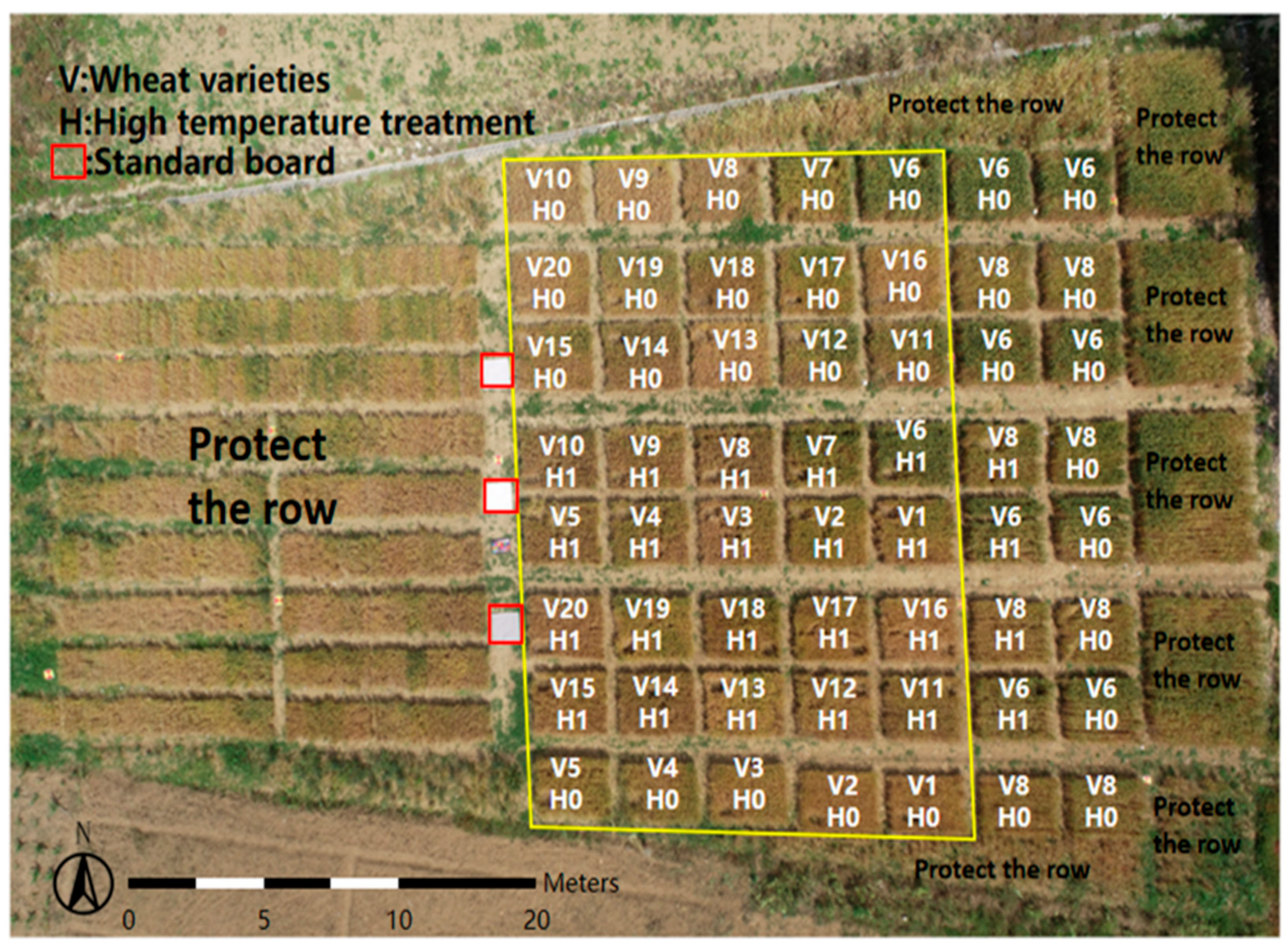

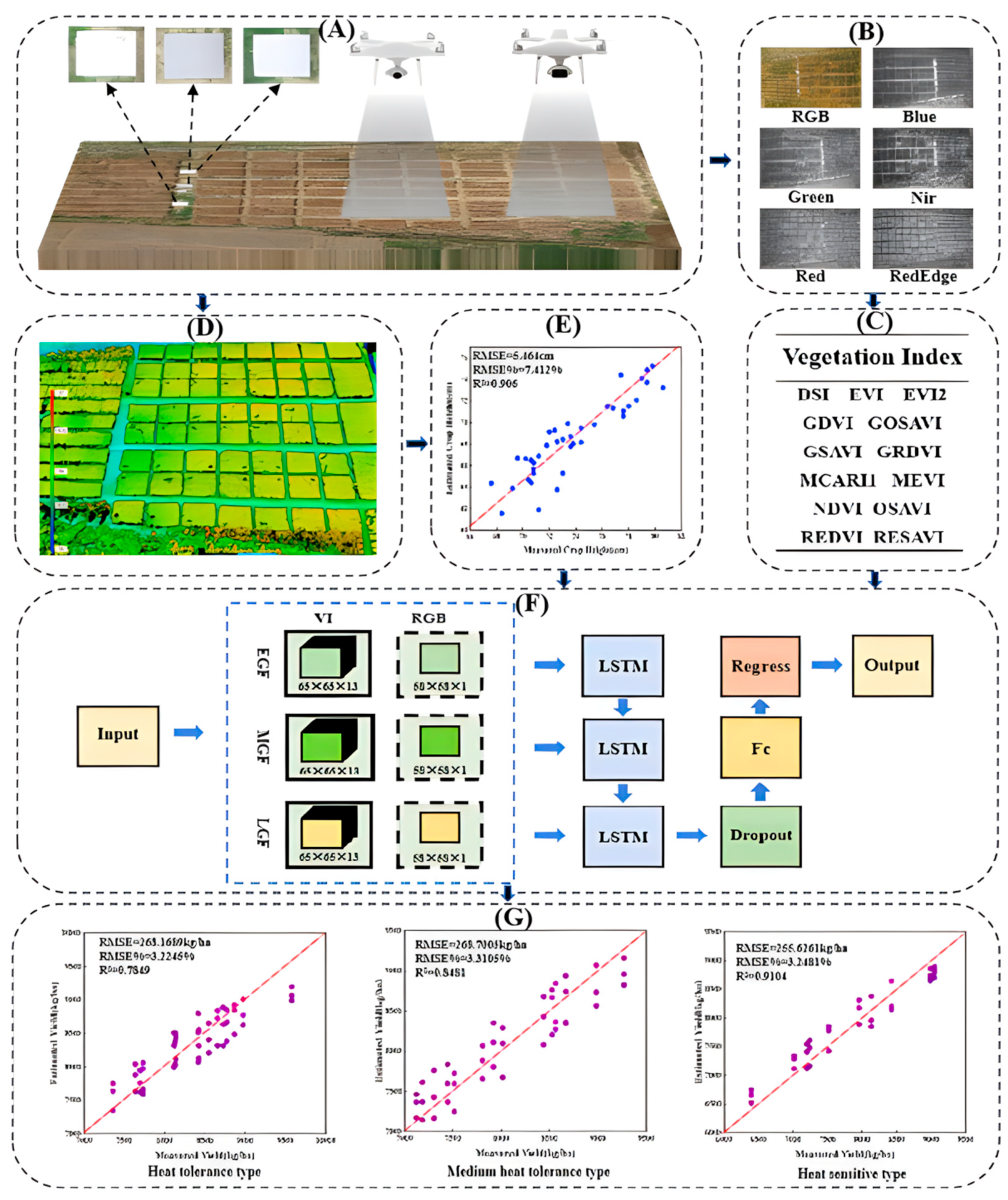
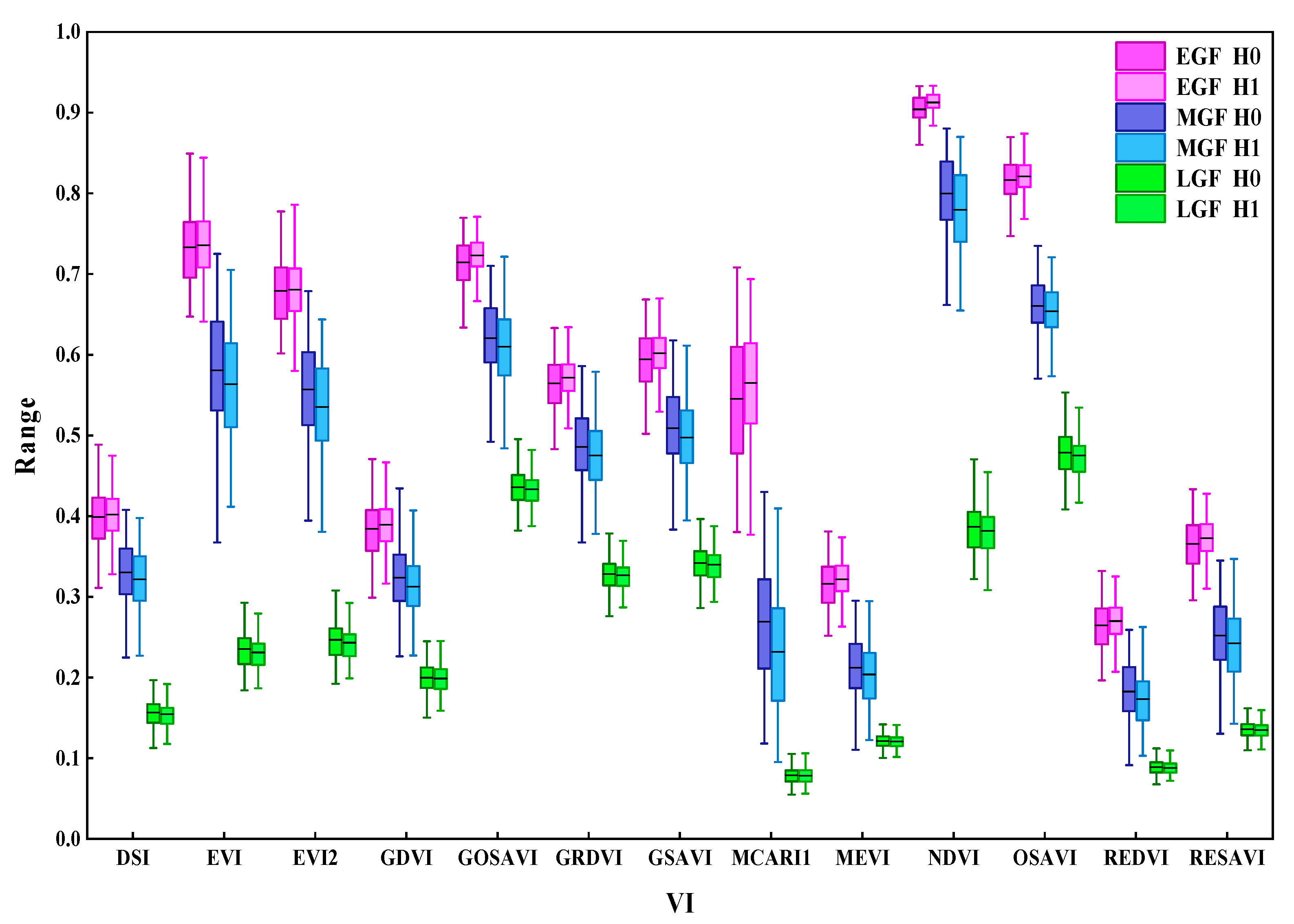
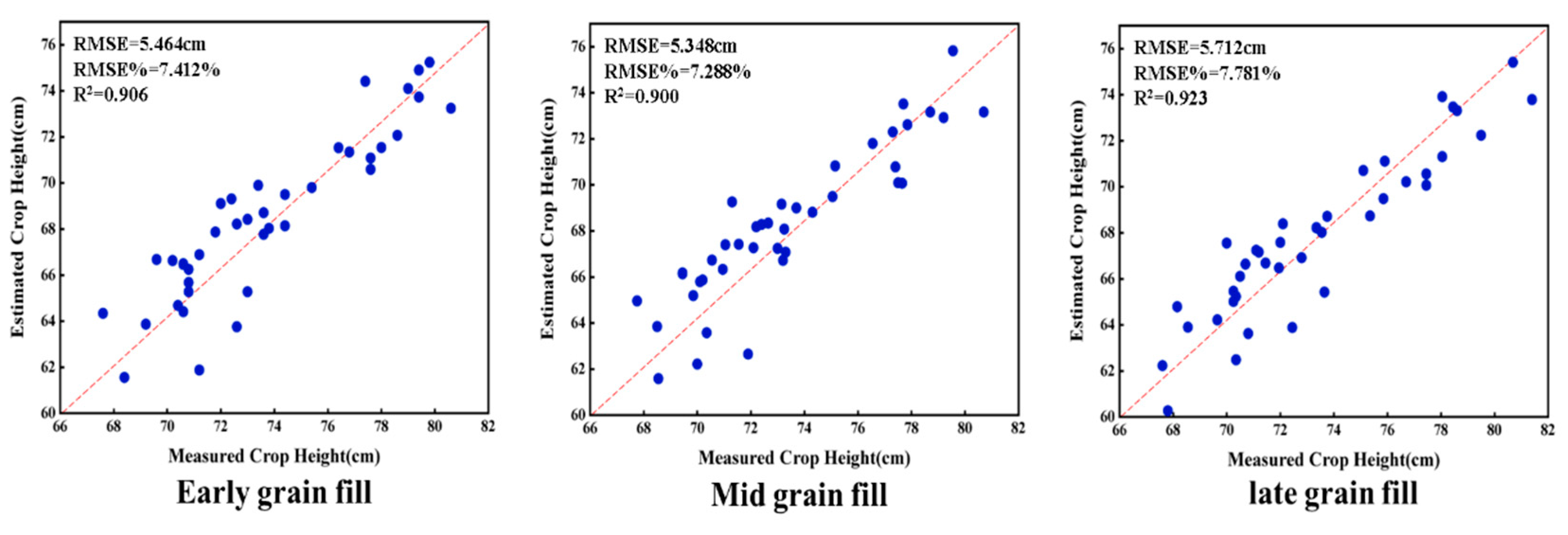
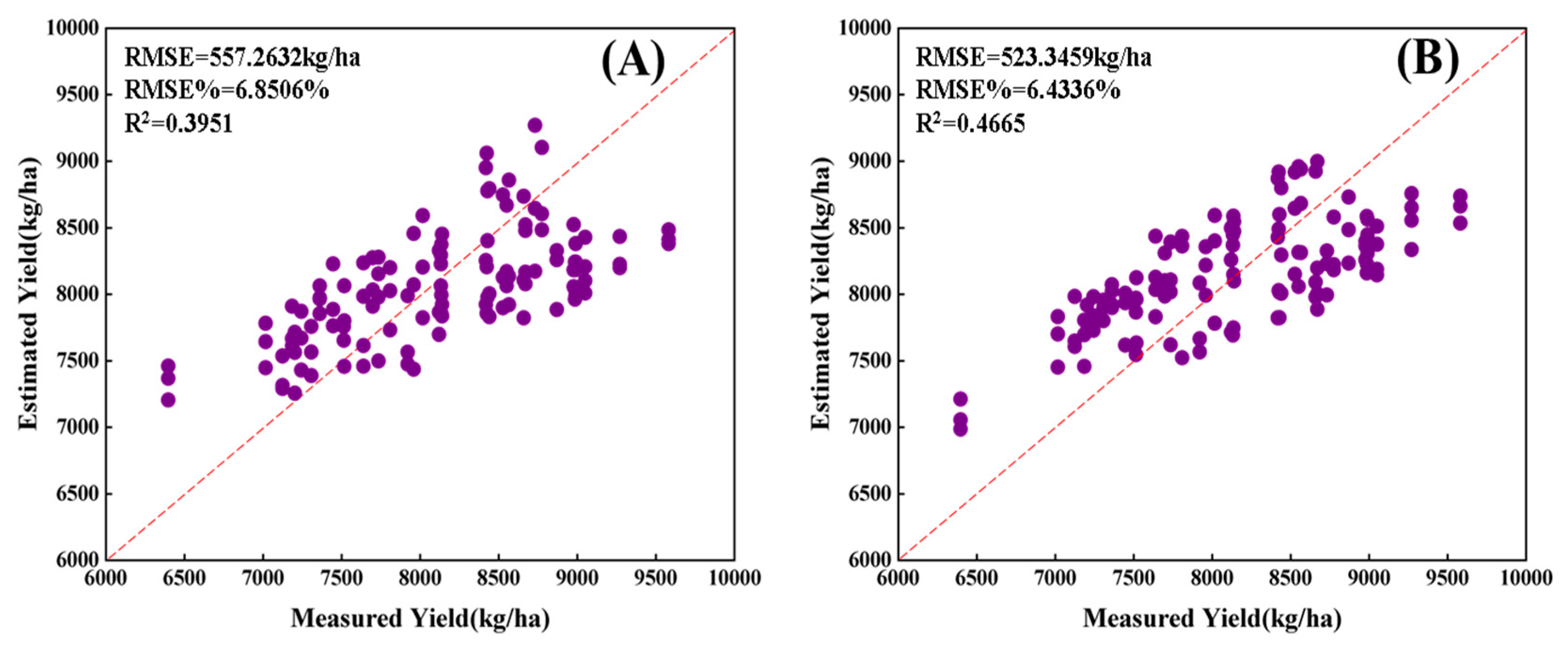
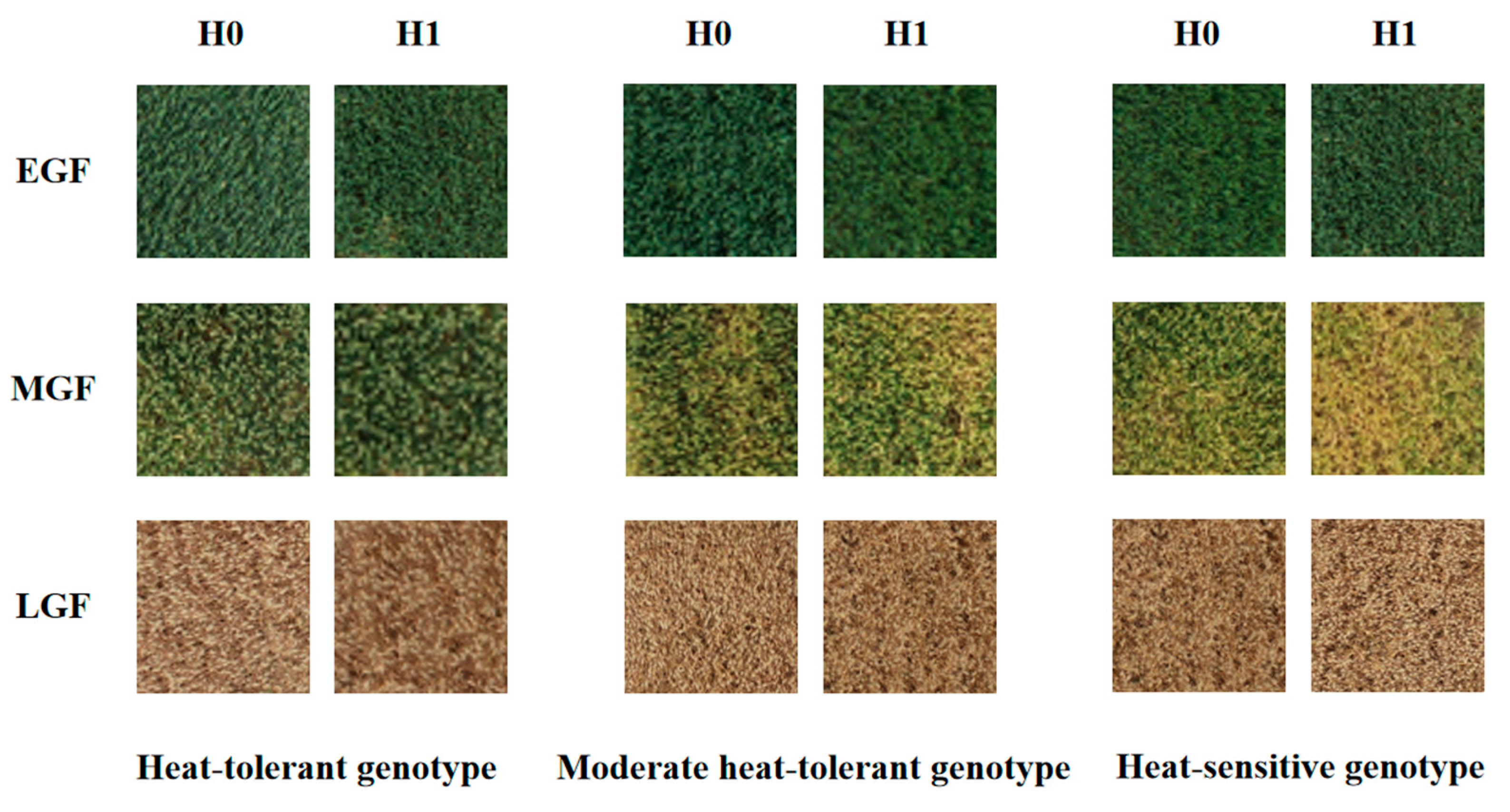
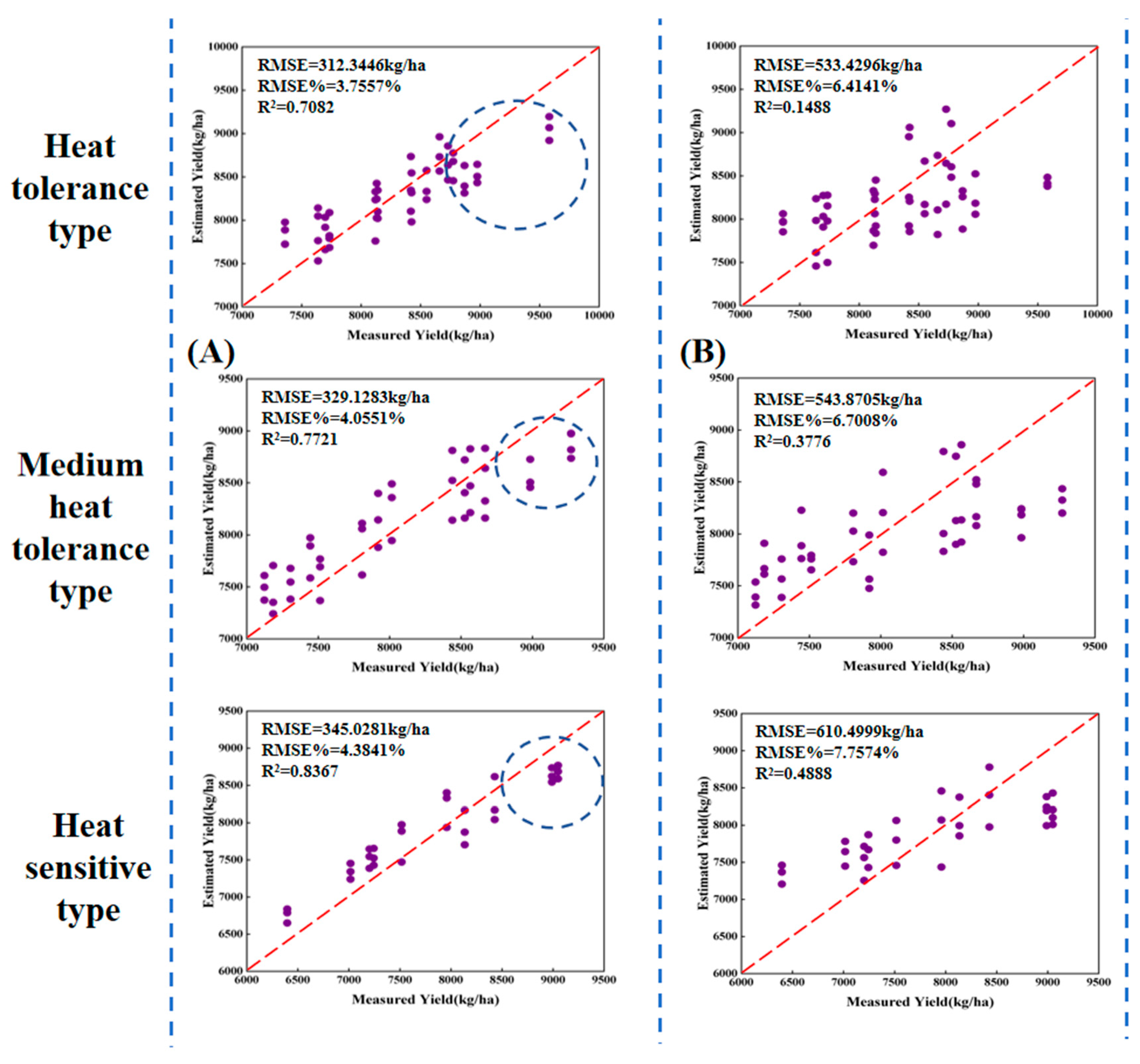


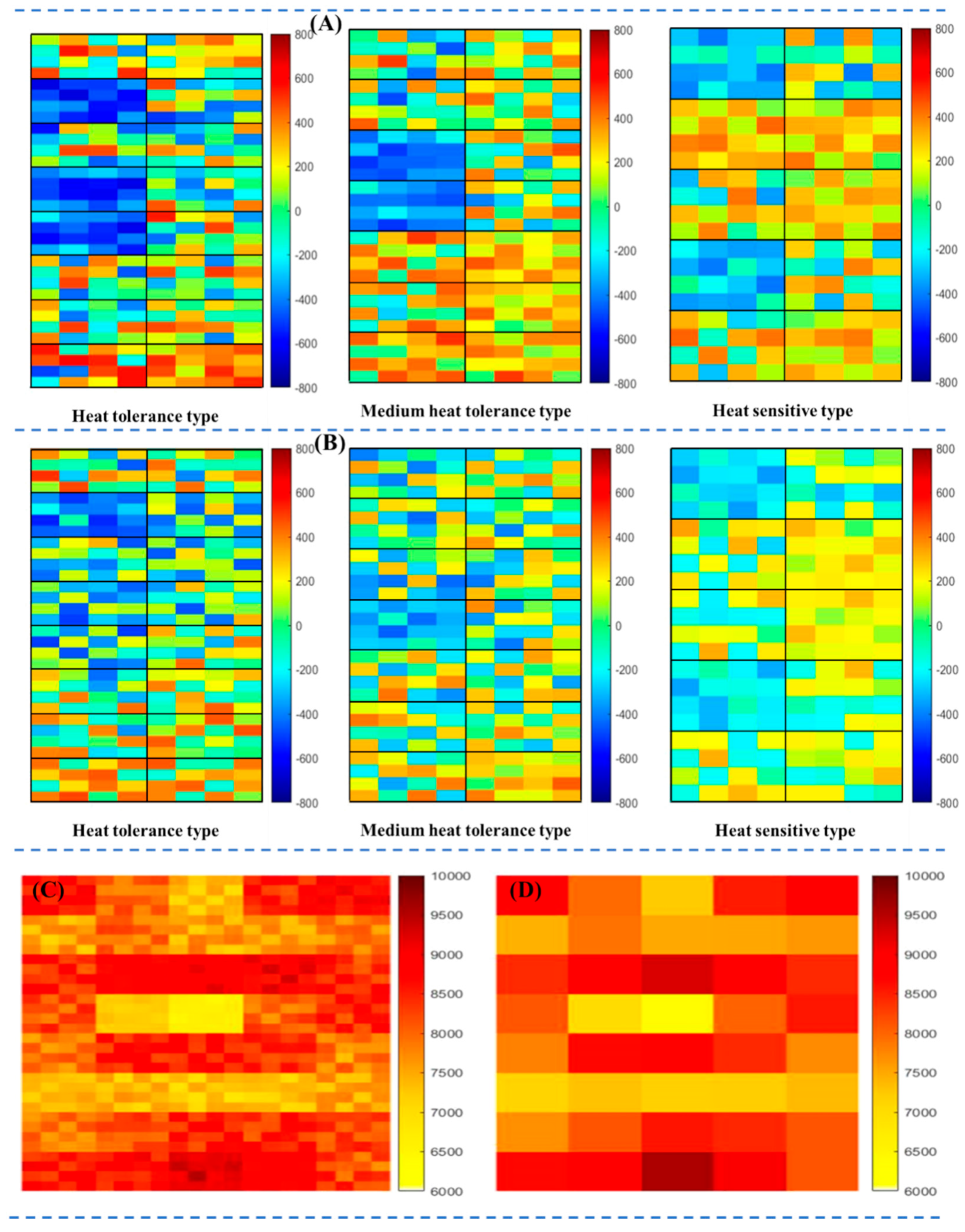
| Wheat Variety | |||
|---|---|---|---|
| V1 | Zhongmai 895 | V11 | Luohan 19 |
| V2 | Xinkemai 169 | V12 | Bainong 207 |
| V3 | Zhongmai 175 | V13 | Luomai 26 |
| V4 | Zhengmai 136 | V14 | Xinmai 36 |
| V5 | Liangxing 99 | V15 | Fengdecunmai 5 |
| V6 | Huaimai 33 | V16 | Fengdecunmai 21 |
| V7 | Annong 0711 | V17 | Fengdecunmai 1 |
| V8 | Huacheng 3366 | V18 | Zhengmai 369 |
| V9 | Zhoumai 27 | V19 | Zhoumai 36 |
| V10 | Luohan 22 | V20 | Zhengmai 366 |
| Features | Formulation | Reference |
|---|---|---|
| Difference spectral index | DSI = NIR − R | [49] |
| Enhanced vegetation index | EVI = 2.5 × (NIR − R)/(1 + NIR − 6 × R − 7.5 × B) | [50] |
| Two-band enhanced vegetation index | EVI2 = 2.5 × (NIR − R)/(NIR + 2.4 × R + 1) | [51] |
| Green difference vegetation index | GDVI = NIR − G | [49] |
| Green optimal soil adjusted vegetation index | GOSAVI = (1 + 0.16)(NIR − G)/(NIR + G + 0.16) | [52] |
| Green re-normalized different vegetation index | GRDVI = (NIR − G)/SQRT(NIR + G) | [53] |
| Green soil adjusted vegetation index | GSAVI = 1.5(NIR − G)/(NIR + G + 0.5) | [54] |
| Modified chlorophyll absorption in reflectance index 1 | MCARI1 = [(NIR − RE) − 0.2 × (NIR − G)](NIR/RE) | [55] |
| Modified enhanced vegetation index | MEVI = 2.5 × (NIR − RE)/(NIR + 6 × RE − 7.5 × G + 1) | [56] |
| Normalized difference vegetation index | NDVI = (NIR − R)/(NIR + R) | [57] |
| Optimized soil-adjusted vegetation index | OSAVI = 1.16 (NIR − R)/(NIR + R + 0.16) | [52] |
| Red edge difference vegetation index | REDVI = NIR − RE | [49] |
| Red edge soil adjusted vegetation index | RESAVI = 1.5 × [(NIR − RE)/(NIR + RE + 0.5)] | [54] |
| No. | Cultivar | Control Yield (kg/ha) | High Temperature Yield (kg/ha) |
|---|---|---|---|
| V1 | Zhongmai 895 | 8139 | 7734 |
| V2 | Xinkemai 169 | 9049 | 8428 |
| V3 | Zhongmai 175 | 9581 | 8730 |
| V4 | Zhengmai 136 | 8774 | 8659 |
| V5 | Liangxing 99 | 8669 | 7808 |
| V6 | Huaimai 33 | 8976 | 8550 |
| V7 | Annong 0711 | 8527 | 8016 |
| V8 | Huacheng 3366 | 7243 | 6396 |
| V9 | Zhoumai 27 | 7959 | 7016 |
| V10 | Luohan 22 | 8869 | 8120 |
| V11 | Luohan 19 | 8424 | 8131 |
| V12 | Bainong 207 | 8985 | 8440 |
| V13 | Luomai 26 | 9270 | 8565 |
| V14 | Xinmai 36 | 8989 | 8134 |
| V15 | Fengdecunmai 5 | 8418 | 7698 |
| V16 | Fengdecunmai 21 | 7639 | 7361 |
| V17 | Fengdecunmai 1 | 7517 | 7202 |
| V18 | Zhengmai 369 | 7514 | 7185 |
| V19 | Zhoumai 36 | 7920 | 7307 |
| V20 | Zhengmai 366 | 7445 | 7123 |
| Machine Learning Models | R2 | RMSE | RMSE% |
|---|---|---|---|
| PLSR | 0.2109 | 636.4563 | 7.8241 |
| RF | 0.2884 | 604.3907 | 7.4299 |
| SVR | 0.2685 | 612.7971 | 7.5333 |
| BP NN | 0.1882 | 645.5558 | 7.9360 |
| LSTM | 0.3951 | 557.2632 | 6.8506 |
| No. | Cultivar | Drought Tolerance | No. | Cultivar | Drought Tolerance |
|---|---|---|---|---|---|
| V1 | Zhongmai 895 | HTG | V11 | Luohan 19 | HTG |
| V2 | Xinkemai 169 | HSG | V12 | Bainong 207 | MHTG |
| V3 | Zhongmai 175 | HTG | V13 | Luomai 26 | MHTG |
| V4 | Zhengmai 136 | HTG | V14 | Xinmai 36 | HSG |
| V5 | Liangxing 99 | MHTG | V15 | Fengdecunmai 5 | HTG |
| V6 | Huaimai 33 | HTG | V16 | Fengdecunmai 21 | HTG |
| V7 | Annong 0711 | MHTG | V17 | Fengdecunmai 1 | HSG |
| V8 | Huacheng 3366 | HSG | V18 | Zhengmai 369 | MHTG |
| V9 | Zhoumai 27 | HSG | V19 | Zhoumai 36 | MHTG |
| V10 | Luohan 22 | HTG | V20 | Zhengmai 366 | MHTG |
Disclaimer/Publisher’s Note: The statements, opinions and data contained in all publications are solely those of the individual author(s) and contributor(s) and not of MDPI and/or the editor(s). MDPI and/or the editor(s) disclaim responsibility for any injury to people or property resulting from any ideas, methods, instructions or products referred to in the content. |
© 2024 by the authors. Licensee MDPI, Basel, Switzerland. This article is an open access article distributed under the terms and conditions of the Creative Commons Attribution (CC BY) license (https://creativecommons.org/licenses/by/4.0/).
Share and Cite
Cheng, T.; Li, M.; Quan, L.; Song, Y.; Lou, Z.; Li, H.; Du, X. A Multimodal and Temporal Network-Based Yield Assessment Method for Different Heat-Tolerant Genotypes of Wheat. Agronomy 2024, 14, 1694. https://doi.org/10.3390/agronomy14081694
Cheng T, Li M, Quan L, Song Y, Lou Z, Li H, Du X. A Multimodal and Temporal Network-Based Yield Assessment Method for Different Heat-Tolerant Genotypes of Wheat. Agronomy. 2024; 14(8):1694. https://doi.org/10.3390/agronomy14081694
Chicago/Turabian StyleCheng, Tianyu, Min Li, Longzhe Quan, Youhong Song, Zhaoxia Lou, Hailong Li, and Xiaocao Du. 2024. "A Multimodal and Temporal Network-Based Yield Assessment Method for Different Heat-Tolerant Genotypes of Wheat" Agronomy 14, no. 8: 1694. https://doi.org/10.3390/agronomy14081694






